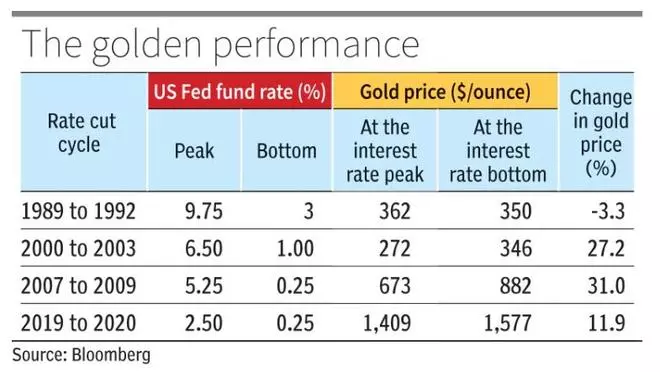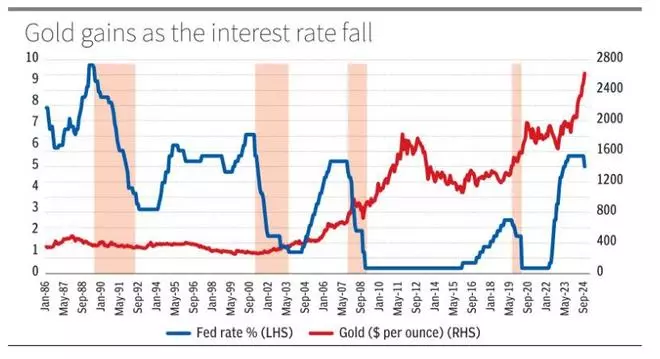The much-awaited rate cut from the US Federal Reserve is finally here. History suggests that gold can gain more sheen than other assets such as equities, currencies or bonds during the rate cut cycle in the US.
The Fed came up with a bang last week by cutting the interest rates by 50-basis points (bps) on Wednesday. Their projections (dot plot) also indicated the possibility of another 50-bps cut for the rest of the year. The forecast also keeps the doors open for another 100-bps cut in 2025 and a 50-bps cut in 2026.
- Editorial. Fed cuts loose
Gold shines
A study on the US rate cut cycles since 1989 reveals that barring the 1989-1992 period of rate cuts in the US, gold price has risen well during other rate cut cycle phases. The global spot gold price fell 3 per cent from $362 per ounce to $350 per ounce when the interest rates in the US was cut from a peak of 9.75 per cent (in May 1989) to 3 per cent in (September 1992).

However, the three major rate cut cycles after that have been very good for gold. Among these three cycles, the 2007-2008 rate cut phase was the best where gold price surged 31 per cent. In the other two rate cut cycles, that is in 2000-2003 and 2019-2020, gold price rose about 27 per cent and 12 per cent, respectively.
Driving factors
Two major factors drove the gold price higher during the last three rate cut cycles. Firstly, the US Treasury yields fell sharply all along the rate cut cycles. The Treasury yields and the gold price have a strong inverse correlation. So, as the yields fell, gold prices rose. For instance, during the 2000-2003 rate cut cycle, the US 10-year Treasury yield fell from 5.1 per cent to 3.5 per cent. Gold price surged 27 per cent at that time.
Secondly, all the three rate cut cycles has witnessed a crisis in some form. The dot com bubble and the 9/11 attack happened during the 2000-2003 rate cut cycles. Similarly, the Global Financial Crisis (GFC) happened during the 2007-2008 rate cut cycle.

Now that the rate cut cycle has begun, will there be a crisis again this time? Amit Goel, Co-Founder & Chief Global Strategist, Pace 360, says, “there is 80 per cent probability that the US is going into a recession in the next twelve months. The Fed can bring down the interest rates to 2 per cent by 2026.”
- Read: Fed rate cuts: Despite 50-bps rate cut, Jerome Powell says not going back to the era of easy money
Sachin Jain, Regional CEO, India, World Gold Council, says, “the 50-bps rate cut this time purely suggests that the Fed is seeking to pre-empt some weakening in the US economy and the labour market”. However, he does not foresee a recession but only a slowdown.
Outlook
Experts believe that the gold price can see a correction and then go up again. Apart from the rate cuts, there are other factors that can support the yellow metal price. The global central banks running into a buying spree last year was one on the reasons for the gold price surge. “Central banks have stepped back from buying for some time now. If they come back into the picture again and increase the pace of buying, that can push gold price higher”, says, a Commodity and Currency analyst from Emkay Global Financial Services. “In a survey conducted among the central banks, 29 per cent of them had said that they will continue to buy gold for reserves,” adds Sachin.
A possible increase in demand from the Exchange Traded Funds (ETFs) can be another factor that can push the price higher. Dr. Renisha Chainani, Head of Research – Augmont – Gold For All, says, “Last year ETFs were absent in the market. But this year their demand is high. So, this can support gold price to go up”. According to Renisha, there can be a 4-5 per cent correction in gold price from current levels for the rest of September after which the price can rise in the final quarter this year. “Festive season physical demand can drive the gold prices higher in the last quarter this year and more rate cuts from the Fed in 2025 will be positive for gold price to go further higher next year,” says Renisha.


